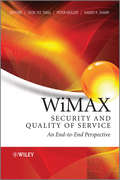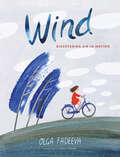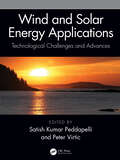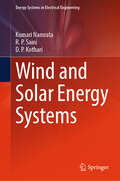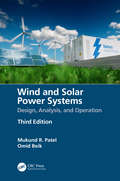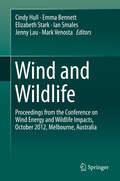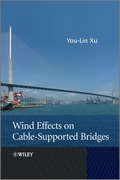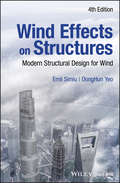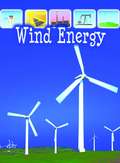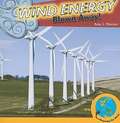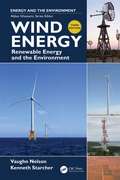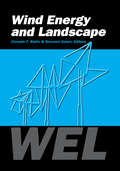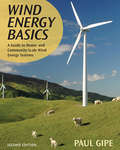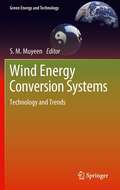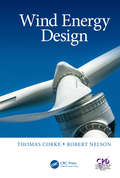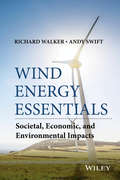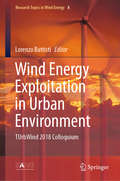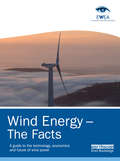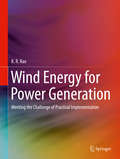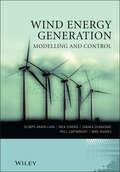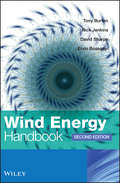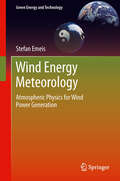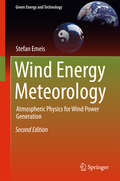- Table View
- List View
WiMAX Security and Quality of Service
by Peter Muller Hamid Sharif Seok-Yee TangWiMAX is the first standard technology to deliver true broadband mobility at speeds that enable powerful multimedia applications such as Voice over Internet Protocol (VoIP), online gaming, mobile TV, and personalized infotainment. WiMAX Security and Quality of Service, focuses on the interdisciplinary subject of advanced Security and Quality of Service (QoS) in WiMAX wireless telecommunication systems including its models, standards, implementations, and applications. Split into 4 parts, Part A of the book is an end-to-end overview of the WiMAX architecture, protocol, and system requirements. Security is an essential element in the wireless world and Part B is fully dedicated to this topic. Part C provides an in depth analysis of QoS, including mobility management in WiMAX. Finally, Part D introduces the reader to advanced and future topics.One of the first texts to cover security, QoS and deployments of WiMAX in the same book. Introduces the primary concepts of the interdisciplinary nature of WiMAX security and QoS, and also includes discussion of hot topics in the field. Written for engineers and researchers, answering practical questions from industry and the experimental field in academia. Explains how WiMAX applications' security and QoS are interconnected and interworked among the cross layers.
Winchester Shotguns
by Dennis AdlerIn the study and appreciation of American history, and in understanding the crucial role played by firearms in that extraordinary saga, one of the most famous gunmakers is Winchester. Their products are so much in demand that they indisputably hold the title of the Blue Chips of gun collecting. And while a notable amount of literature on these marques has appeared in print, much of it from the period of post-World War II, there are still major categories which demand focused books. Such works are in response not only to the "need to know" from students, historians and collectors, but also are a powerful reflection of the ever-expanding explosion of interest in the magical world of firearms. The study of arms is a highly visual, and technical, pursuit. Having the objects sitting on a page, as if they are on the reader's desk, is a true delight. Few photographers can equal those images of excellence. And no one today can match his combination of skill, aptitude and artistry at doing both text and photographs
Wind
by Olga FadeevaA browsable, appealing introduction to an important weather phenomenon.If your hair has ever blown back on a breezy day, you&’ve noticed the wind at work. But what causes the wind? Are there different types of wind? How do we measure and name them? How does the wind shape our ecosystems, plants, and animals? What about people: how have human beings used the wind in the past and the present? Can you really sail into the wind, and would a tailwind help or hurt your plane&’s takeoff? Up, up beyond the clouds, does the wind affect other planets, too? Created with help from a meteorologist, this beautiful book is a fascinating exploration of the wind&’s role in world history and earth science. Playful prose and colorful illustrations invite children to bring their questions along as they learn more about this powerful—but sometimes overlooked—natural element.
Wind and Solar Energy Applications: Technological Challenges and Advances
by Satish Kumar Peddapelli Peter VirticThis book examines the recent advances, from theoretical and applied perspectives, addressing the major issues associated with renewable energy systems, with each chapter covering fundamental issues and latest developments. This book covers important themes, including solar energy equipment, wind and solar energy systems, energy storage and bioenergy applications, hybrid renewable energy systems, as well as the measurement techniques that are used for these systems. Further, it focusses on original research outcomes on various technological developments and provides insights to taxonomy of challenges, issues, and research directions in renewable energy applications. Features: Covers research and technological developments in wind and solar energy applications. Proposes resolution of limitations and performance issues of existing system models and design. Incorporates the challenges of adoption of renewable energies system. Provides hypotheses, mathematical analysis, and real-time practical applications to practical problems. Includes case studies of implementation of solar and wind systems in remote areas. This book is aimed at researchers, professionals, and graduate students in electrical and mechanical engineering and renewable energy.
Wind and Solar Energy Systems (Energy Systems in Electrical Engineering)
by D. P. Kothari Kumari Namrata R. P. SainiThis book is designed to serve as a textbook for courses on renewable energy technology tragetted at upper undergraduate or graduate students. This book can also be used as a core or supplementary text for courses in energy conservation and management and solar photo-voltaic design and application. This textbook covers the basic concepts of renewable energy resources, especially wind and solar energy. It contains 8 chapters covering all major renewable energy systems, resources, and related topics, as well as a brief introductory chapter on grid integration techniques in solar and wind energy systems. The book includes pedagogical features like examples and review questions and multiple choice questions to help the readers test their understanding. Reading lists, including web-based material, are included at the end of each chapter. The structure and pedagogy makes this book useful for self-study as well as for classroom use. The book can also be used as text for professional development courses for engineers employed in the energy industry.
Wind and Solar Power Systems: Design, Analysis, and Operation
by Mukund R. Patel Omid BeikThis book provides technological and socio-economic coverage of renewable energy. It discusses wind power technologies, solar photovoltaic technologies, large-scale energy storage technologies, and ancillary power systems. In this new edition, the book addresses advancements that have been made in renewable energy: grid-connected power plants, power electronics converters, and multi-phase conversion systems. The text has been revised to include up-to-date material, statistics, and current technology trends. Three new chapters have been added to cover turbine generators, AC and DC wind systems, and recent advances solar power conversion. Discusses additional renewable energy sources, such as ocean, special turbines, etc. Covers system integration for solar and wind energy Presents emerging DC wind systems Includes coverage on turbine generators Updated sections on solar power conversion It offers students, practicing engineers, and researchers a comprehensive look at wind and solar power technologies. It is designed as a reference and can serve as a textbook for senior undergraduates in a one-semester course on renewable power or energy systems.
Wind and Wildlife
by Cindy Hull Emma Bennett Elizabeth Stark Ian Smales Jenny Lau Mark VenostaThis book gathers papers presented and discussions held at the Conference on Wind Energy and Wildlife Impacts in Melbourne, Australia on 9th October 2012. The purpose of the conference was to bring together researchers, industry, consultants, regulators and Non-Government Organizations to share the results of studies into wind farm and wildlife investigations in Australia and New Zealand. The aim was to further networking and communication between these groups. The conference discussed key issues and areas for future investigation, with the intention of developing consistencies in research and management. Like the Conference, the book showcases current research and management in the field of wind farms and wildlife in Australia and New Zealand; establishes consistencies in research and management; and highlights areas in need of further examination. The papers in these Proceedings are presented in two session topics. The first covers "Investigations and assessment of new wind farms" and the second, "Monitoring, mitigation and offsets. " The Proceedings then summarize the panel discussions held at the end of the conference. The themes include improving pre- and post-construction survey design; identifying key knowledge gaps and research priorities; uncertainties and errors in data sets and analysis; creating opportunities to share knowledge; and assessing cumulative impacts across multiple sites.
The Wind at Work: An Activity Guide to Windmills
by Gretchen WoelfleExplaining how the wind works, what windmills have contributed to the past, and why they offer environmental promise today as a source of clean, renewable energy, this revised and updated edition offers a glimpse into all the current and historical uses for wind power. Featuring new information on wind energy technology and wind farms, new photographs, and 24 wind-related activities--from keeping track of household energy use and conducting science experiments to cooking traditional meals and creating arts and crafts--this handy resource offers kids interested in the science of energy and green technologies an engaging, interactive, and contemporary overview of wind power.
Wind Effects on Cable-Supported Bridges
by You-Lin XuAs an in-depth guide to understanding wind effects on cable-supported bridges, this book uses analytical, numerical and experimental methods to give readers a fundamental and practical understanding of the subject matter. It is structured to systemically move from introductory areas through to advanced topics currently being developed from research work. The author concludes with the application of the theory covered to real-world examples, enabling readers to apply their knowledge.The author provides background material, covering areas such as wind climate, cable-supported bridges, wind-induced damage, and the history of bridge wind engineering. Wind characteristics in atmospheric boundary layer, mean wind load and aerostatic instability, wind-induced vibration and aerodynamic instability, and wind tunnel testing are then described as the fundamentals of the subject. State-of-the-art contributions include rain-wind-induced cable vibration, wind-vehicle-bridge interaction, wind-induced vibration control, wind and structural health monitoring, fatigue analysis, reliability analysis, typhoon wind simulation, non-stationary and nonlinear buffeting response. Lastly, the theory is applied to the actual long-span cable-supported bridges.Structured in an easy-to-follow way, covering the topic from the fundamentals right through to the state-of-the-artDescribes advanced topics such as wind and structural health monitoring and non-stationary and nonlinear buffeting responseGives a comprehensive description of various methods including CFD simulations of bridge and vehicle loadingUses two projects with which the author has worked extensively, Stonecutters cable-stayed bridge and Tsing Ma suspension bridge, as worked examples, giving readers a practical understanding
Wind Effects on Structures: Modern Structural Design for Wind (Sessions Proceedings Ser.)
by DongHun Yeo Emil SimiuProvides structural engineers with the knowledge and practical tools needed to perform structural designs for wind that incorporate major technological, conceptual, analytical and computational advances achieved in the last two decades. With clear explanations and documentation of the concepts, methods, algorithms, and software available for accounting for wind loads in structural design, it also describes the wind engineer's contributions in sufficient detail that they can be effectively scrutinized by the structural engineer in charge of the design. Wind Effects on Structures: Modern Structural Design for Wind, 4th Edition is organized in four sections. The first covers atmospheric flows, extreme wind speeds, and bluff body aerodynamics. The second examines the design of buildings, and includes chapters on aerodynamic loads; dynamic and effective wind-induced loads; wind effects with specified MRIs; low-rise buildings; tall buildings; and more. The third part is devoted to aeroelastic effects, and covers both fundamentals and applications. The last part considers other structures and special topics such as trussed frameworks; offshore structures; and tornado effects. Offering readers the knowledge and practical tools needed to develop structural designs for wind loadings, this book: Points out significant limitations in the design of buildings based on such techniques as the high-frequency force balance Discusses powerful algorithms, tools, and software needed for the effective design for wind, and provides numerous examples of application Discusses techniques applicable to structures other than buildings, including stacks and suspended-span bridges Features several appendices on Elements of Probability and Statistics; Peaks-over-Threshold Poisson-Process Procedure for Estimating Peaks; estimates of the WTC Towers’ Response to Wind and their shortcomings; and more Wind Effects on Structures: Modern Structural Design for Wind, 4th Edition is an excellent text for structural engineers, wind engineers, and structural engineering students and faculty.
Wind Energy (Let's Explore Global Energy)
by David Armentrout Patricia ArmentroutIntroduces methods of obtaining power from the wind, places wind power in context with other power resources, explains how it works, and considers the advantages and disadvantages of its possible future use.
Wind Energy: Blown Away! (Powering Our World)
by Amy HansenExplains how wind energy is generated and used, discusses wind farms and turbines, and considers its use as a renewable resource.
Wind Energy: Renewable Energy And The Environment
by Vaughn Nelson Kenneth StarcherThis book explores the wind industry from its inception in the 1970s to today; presents the design, aerodynamics, operation, control, applications, and different types of wind turbines; and provides ample reasons to shift from fossil fuels to renewable energy. It also discusses the political and economic factors regarding the adoption of wind as an energy source. It covers the characteristics of wind, such as shear, power potential, and turbulence, and discusses the measurement and siting of individual wind turbines and wind farms. This new edition is fully updated throughout, and adds new material on wind forecasting, offshore wind, decommissioning and repowering wind farms, and more.
Wind Energy and Landscape: Proceedings of the international workshop WEL, Genova, Italy, 26-27 June 1997
by Corrado F.Ratto and Giovanni SolariArising from an international workshop, these papers discuss aspects of wind turbines and the landscape. Topics: Harmonization of wind turbines with landscape; Visual and audio impact of wind turbines; Interference with telecommunication; Impact of wind turbines on birds; Real experiences in different countries; Offshore wind farms; Wind turbines in coastal and mountainous areas; Wind turbines, thunderstorms and lightning; Economic and social impact of wind turbines; Insurance policies regarding wind turbines; Greater public acceptance of wind turbines.
Wind Energy Basics
by Paul GipeThe availability of clean, renewable power is without question going to be the defining challenge and goal of the 21st century, and wind will lead the way. Internationally acclaimed wind energy expert Paul Gipe is as soberly critical of past energy mistakes as he is convincingly optimistic about the future. The overwhelming challenge of transforming our world from one of fossil carbon to one of clean power seems daunting at best-and paralyzingly impractical at worst. "Wind Energy Basics" offers a solution. Wind power can realistically not only replace the lion's share of oil-, coal-, and natural gas- fired electrical plants in the U. S. , but also can add enough extra power capacity to allow for most of the cars in the nation to run on electricity. Gipe explains why such a startlingly straightforward solution is eminently doable and can be accomplished much sooner than previously thought-and will have the capacity to resuscitate small and regional economies. "Wind Energy Basics" offers a how-to for home-based wind applications, with advice on which wind turbines to choose and which to avoid. He guides wind-energy installers through considerations such as renewable investment strategies and gives cautionary tales of wind applications gone wrong. And for the activist, he suggests methods of prodding federal, state, and provincial governments to promote energy independence.
Wind Energy Conversion Systems
by S. M. MuyeenWind Energy Conversion System covers the technological progress of wind energy conversion systems, along with potential future trends. It includes recently developed wind energy conversion systems such as multi-converter operation of variable-speed wind generators, lightning protection schemes, voltage flicker mitigation and prediction schemes for advanced control of wind generators. Modeling and control strategies of variable speed wind generators are discussed, together with the frequency converter topologies suitable for grid integration. Wind Energy Conversion System also describes offshore farm technologies including multi-terminal topology and space-based wind observation schemes, as well as both AC and DC based wind farm topologies. The stability and reliability of wind farms are discussed, and grid integration issues are examined in the context of the most recent industry guidelines. Wind power smoothing, one of the big challenges for transmission system operators, is a particular focus. Fault ride through and frequency fluctuation mitigation using energy storage options are also covered. Efficiency analyses are presented for different types of commercially available wind turbine generator systems, large scale wind generators using superconducting material, and the integration of offshore wind and marine current farms. Each chapter is written by a leader in the wind energy arena, making Wind Energy Conversion System a valuable reference for researchers and students of wind energy.
Wind Energy Design
by Thomas Corke Robert NelsonWind Energy Systems is designed for undergraduate engineering courses, with a focus on multidisciplinary design of a wind energy system. The text covers basic wind power concepts and components - wind characteristics and modeling, rotor aerodynamics, lightweight flexible structures, wind farms, aerodynamics, wind turbine control, acoustics, energy storage, and economics. These topics are applied to produce a new conceptual wind energy design, showing the interplay of various design aspects in a complete system. An ongoing case study demonstrates the integration of various component topics, and MATLAB examples are included to show computerized design analysis procedures and techniques.
Wind Energy Essentials
by Andrew Swift Richard P. WalkerExamines the possible societal impacts of wind energy projects and explains the potential issues faced when siting, constructing, and operating a wind energy project. This book begins with a history of wind power and the social impacts of both electricity and wind power from a historical perspective, a discussion of basic electrical terms, and a primer on the conversion of power in the wind to electricity. Much of the second half of the book is devoted to comparing wind energy to other forms of electric generation, both renewable and non-renewable sources. In order to have a true understanding of the impact of wind energy on society, one also has to have a thorough understanding of the impacts that other sources of electric generation have, such as fossil-fuelled plants or nuclear power plants. The comparison of electric generation sources includes a review of how such sources are typically utilized within the electric system, as well as the economic factors and environmental considerations that affect which resources utilities or operators of electric grids have to take into account. The authors conclude with a discussion of energy policies in the U.S., individual states, and foreign nations, how these policies influence the use of renewable energy, and what our future may hold in terms of energy supply and demand. Some highlights of this book are: Discusses the wind energy impacts on the environment, local economy, electric utilities, individuals and communities Provides a visual explanation of wind energy principles through tables, graphs, maps, illustrations and photographs Offers a comprehensive overview of the issues associated with the creation and use of wind energy Models chapters around an existing university curriculum Spanning the broad range of environmental, financial, policy and other topics that define and determine the relationships between wind energy technology and our energy-dependent society, Wind Energy Essentials is a resource for students, universities, and the entire wind energy industry.
Wind Energy Exploitation in Urban Environment: Turbwind 2017 Colloquium (Green Energy and Technology)
by Lorenzo BattistiThis book presents numerical and experimental research in the field of wind energy exploitation in urban environments. It comprises a selection of the best papers from the international colloquium “Research and Innovation on Wind Energy Exploitation in Urban Environment” (TUrbWind), held in Riva del Garda, Italy in September 2018. The book includes contributions from different research fields in urban wind resources, wind energy conversion systems, and urban integration, mainly focusing on the following topics: <br> · turbine concepts for urban and sub-urban environment; <br> · measuring and modelling wind resource; <br> · rotor aerodynamics, wakes and noise; <br> · design, loads, and supporting structures; <br> · novel shapes and materials; <br>· building concepts for wind energy exploitation; <br> · planning approaches for wind exploitation in urban areas. <P><P> It is a valuable resource for researchers and practitioners interested in the integration of wind energy systems and turbines in urban areas.
Wind Energy - The Facts: A Guide to the Technology, Economics and Future of Wind Power
by European Wind Energy AssociationWind power is often held up as the most accessible and cost-effective route to reducing our reliance on fossil fuels and improving our energy independence, yet knowledge of what it offers is often clouded by myths and misunderstandings, which can hamper its adoption. This new book, the result of an ambitious project coordinated by the European Wind Energy Association, aims to present the facts about wind energy. It includes six sections discussing: - Technology - Grid integration - Economics of wind - Its industry and markets - Its environmental impacts - The scenarios and targets for wind energy Contributions are drawn from nine leading research bodies across Europe, and the material is global in its scope. It is therefore an essential resource and reference for those whose work or study demands an in-depth examination of the subject, and for anyone who wants detailed, accurate and up-to-date information on this key energy source.
Wind Energy for Power Generation: Meeting the Challenge of Practical Implementation
by K. R. RaoThis far-reaching resource covers a full spectrum of multi-faceted considerations critical for energy generation decision makers considering the adoption or expansion of wind power facilities. It contextualizes pivotal technical information within the real complexities of economic, environmental, practical and socio-economic parameters. This matrix of coverage includes case studies and analysis from developed and developing regions, including North America and Europe, Asia, Latin America, the Middle-East and Africa. Crucial issues to power generation professionals and utilities such as: capacity credits; fuel saving; intermittency; penetration limits; relative cost of electricity by generation source; growth and cost trends; incentives; and wind integration issues are addressed. Other economic issues succinctly discussed inform financial commitment to a project, including investment matrices, strategies for economic evaluations, econometrics of wind energy, cost comparisons of various investment strategies, and cost comparisons with other energy sources. Due to its encompassing scope, this reference will be of distinct interest to practicing engineers, policy and decision makers, project planners, investors and students working in the area of wind energy for power generation.
Wind Energy Generation: Modelling and Control
by Michael Hughes Janaka Ekanayake Olimpo Anaya-Lara Nick Jenkins Phill CartwrightWith increasing concern over climate change and the security of energy supplies, wind power is emerging as an important source of electrical energy throughout the world.Modern wind turbines use advanced power electronics to provide efficient generator control and to ensure compatible operation with the power system. Wind Energy Generation describes the fundamental principles and modelling of the electrical generator and power electronic systems used in large wind turbines. It also discusses how they interact with the power system and the influence of wind turbines on power system operation and stability. Key features:Includes a comprehensive account of power electronic equipment used in wind turbines and for their grid connection.Describes enabling technologies which facilitate the connection of large-scale onshore and offshore wind farms.Provides detailed modelling and control of wind turbine systems.Shows a number of simulations and case studies which explain the dynamic interaction between wind power and conventional generation.
Wind Energy Handbook
by David Sharpe Tony Burton Ervin Bossanyi Nick JenkinsNamed as one of Choice's Outstanding Academic Titles of 2012Every year, Choice subject editors recognise the most significant print and electronic works reviewed in Choice during the previous calendar year. Appearing annually in Choice's January issue, this prestigious list of publications reflects the best in scholarly titles and attracts extraordinary attention from the academic library community.The authoritative reference on wind energy, now fully revised and updated to include offshore wind powerA decade on from its first release, the Wind Energy Handbook, Second Edition, reflects the advances in technology underpinning the continued expansion of the global wind power sector. Harnessing their collective industrial and academic expertise, the authors provide a comprehensive introduction to wind turbine design and wind farm planning for onshore and offshore wind-powered electricity generation.The major change since the first edition is the addition of a new chapter on offshore wind turbines and offshore wind farm development. Opening with a survey of the present state of offshore wind farm development, the chapter goes on to consider resource assessment and array losses. Then wave loading on support structures is examined in depth, including wind and wave load combinations and descriptions of applicable wave theories. After sections covering optimum machine size and offshore turbine reliability, the different types of support structure deployed to date are described in turn, with emphasis on monopiles, including fatigue analysis in the frequency domain. Final sections examine the assessment of environmental impacts and the design of the power collection and transmission cable network.New coverage features:turbulence models updated to reflect the latest design standards, including an introduction to the Mann turbulence modelextended treatment of horizontal axis wind turbines aerodynamics, now including a survey of wind turbine aerofoils, dynamic stall and computational fluid dynamicsdevelopments in turbine design codestechniques for extrapolating extreme loads from simulation resultsan introduction to the NREL cost modelcomparison of options for variable speed operationin-depth treatment of individual blade pitch controlgrid code requirements and the principles governing the connection of large wind farms to transmission networksfour pages of full-colour pictures that illustrate blade manufacture, turbine construction and offshore support structure installationFirmly established as an essential reference, Wind Energy Handbook, Second Edition will prove a real asset to engineers, turbine designers and wind energy consultants both in industry and research. Advanced engineering students and new entrants to the wind energy sector will also find it an invaluable resource.
Wind Energy Meteorology
by Stefan EmeisThis book is intended to give an introduction into the meteorological boundary conditions for power generation from the wind, onshore and offshore. It is to provide reliable meteorological information for the planning and running of this important kind of renewable energy. This includes the derivation of wind laws and wind profile descriptions, especially those above the logarithmic surface layer. Winds over complex terrain and nocturnal low-level jets are considered as well. A special chapter is devoted to the efficiency of large wind parks and their wakes.
Wind Energy Meteorology: Atmopsheric Physics For Wind Power Generation (Green Energy And Technology)
by Stefan EmeisThis book offers an introduction to the meteorological boundary conditions for power generation from wind – both onshore and offshore, and provides meteorological information for the planning and running of this important renewable energy source. It includes the derivation of wind laws and wind-profile descriptions, especially those above the logarithmic surface layer, and discusses winds over complex terrains and nocturnal low-level jets. This updated and expanded second edition features new chapters devoted to the efficiency of large wind parks and their wakes and to offshore wind energy.
